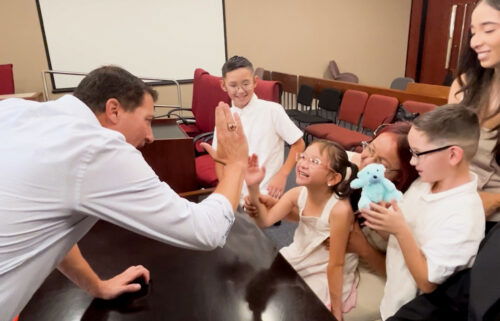Cherokee cyclists complete ‘Remember the Removal’ ride, reflect on challenges ancestors faced on Trail of Tears
Click here for updates on this story
TAHLEQUAH, Oklahoma (Tulsa World) — Around 11 a.m. Friday, as the sun continued its morning ascent and brought with it a harsh 90-degree day, nine cyclists arrived in Tahlequah to complete a three-week journey of more than 950 miles.
Although the elevated terrain of northeast Oklahoma and the Ozark foothills may have presented a challenge for some, the Cherokee cyclists had already overcome myriad other obstacles. They had conquered steeper slopes in Kentucky and Tennessee, as well as flat tires and broken chains along the entire ride. One rider said she also triumphed over a less tangible, yet equally challenging personal foe.
The bikers’ return to Tahlequah marked the completion of a journey monumental in both its distance and significance. The “Remember the Removal” bike ride is an annual event dedicated to retracing the paths taken by tens of thousands of Native Americans during the Trail of Tears, the federal government’s organized forced removal of indigenous tribes from across the southeast U.S. to Oklahoma reservations.
The riders faced days of intense heat and occasional rainfall from the beginning of their journey in New Echota, Georgia, but said their trek — on bikes, across paved roads — was only a fraction as difficult as what their fellow Cherokees and other native nations endured more than 180 years ago.
“This was just a small glimpse of what our ancestors endured so long ago,” said Kaylee Smith, a rider on the trip representing the Cherokee Nation. “I have learned so many things about being a Cherokee woman and all the responsibilities that come with it. From the beginning, I knew I wanted to educate others about the horrors that happened to our Cherokee ancestors.”
Smith described to the more than 100 attendees at a ceremony welcoming the riders home the nature of the atrocities the Cherokee faced, which the nation has estimated led to the death of 6,000 citizens.
“Many people believe we left by choice — but in reality, our ancestors were driven from our homes,” Smith said. “They were beaten, they were raped and they were forced to live in harsh weather conditions.”
Smith described the surreal sensation of placing her feet on a preserved trail in Port Royal, Tennessee, the same trail the Cherokees were marched down nearly two centuries ago.
Being able to connect with this part of her past — and the bonds created between herself and the other riders — helped give her hope in her personal struggles as well. Smith gave an emotional account of her journey at the welcome ceremony.
“(Around the start of the trip), I was suicidal. I didn’t feel like I had a purpose in life and I didn’t know if I was going to be able to make it,” Smith said. “But being with my teammates made me realize I do have a purpose and I am important. I am a strong Cherokee woman and I can do anything that I set my mind to.”
Raylen Bark, a rider representing the Eastern Band of Cherokee Indians and a sophomore at Dartmouth College, said the process to prepare for the ride was as daunting as the ride itself.
“It’s been crazy. It was really rough and rigorous, as we had to wait two years to complete the ride (due to COVID-19),” Bark said. “But being with my three riders from the Eastern Band and others from the Cherokee Nation … genuinely completed me.”
Through completing the ride, Principal Chief of the Cherokee Nation Chuck Hoskin Jr. said the riders are doing vital work to ensure the continued prosperity of the Cherokee.
“Along the way I have no doubt that the riders saw obstacles they thought they might not overcome,” Hoskin said. “But they were able to keep going and progressing as the Cherokee people have done and as their ancestors have done. (The riders) will inherit a Cherokee nation and future full of challenges, but the future will not be bigger than this generation of riders.”
The celebration of the riders’ accomplishments and remembrance of the Trail of Tears is part of what will help Cherokee culture, heritage and language thrive into the future, the chief said.
The riders were emotional as the journey neared its end, Bark said, and she “cried her eyes out” when she realized the ride would soon be over.
The mental and physical challenges the riders overcame will be with them for their entire lives, Smith said.
“As the distance grows between us and our ancestral land, so does our physical pain,” Smith said. “I’m speechless when people ask me about it. There’s really no words to talk about how mentally and physically exhausting this trip was, but it was so rewarding at the same time.”
Please note: This content carries a strict local market embargo. If you share the same market as the contributor of this article, you may not use it on any platform.




